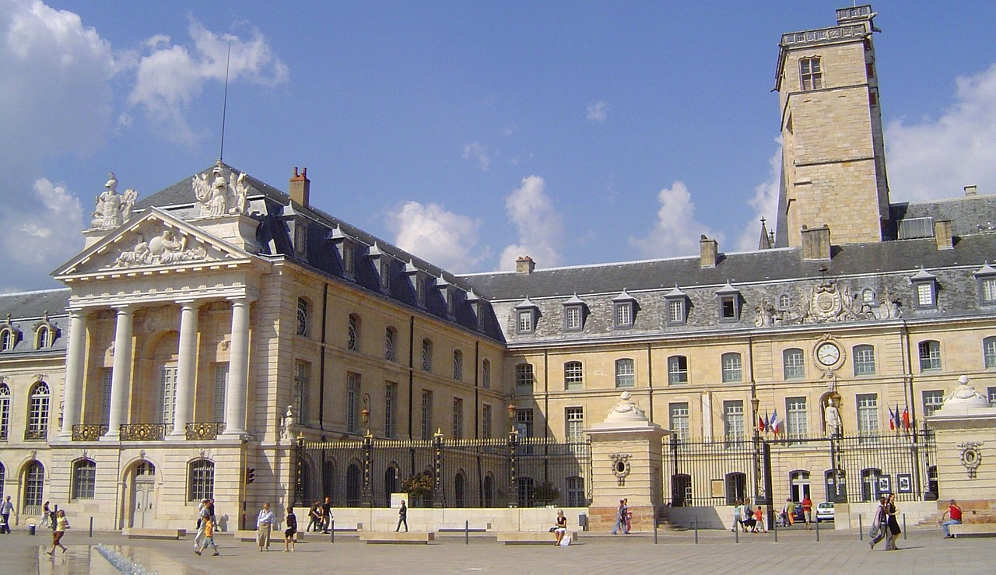About-France.com
- the connoisseur's guide to France
- Explore France ►
- Essential pages
- Travel in France
- Where to go
- What to see and do
Dijon - the capital of Burgundy
| On this page | Location and access | Tourist attractions |
| In the area | Local accommodation |
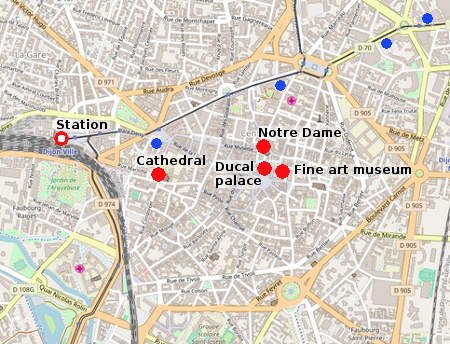
Parking: the blue dots show parking lots near the tram route. Traffic access to the historic centre is limited, but there are numerous car parks and plenty of street parking too.
In the Middle Ages, the Dukes of Burgundy were second only in power to the Kings of France: and indeed for much of the Middle Ages, the Dukedom of Burgundy was to all intents and purposes an independent state, separate from and at times at war with the Kingdom of France.
In the 14th and 15th centuries, the Duchy of Burgundy was a major European power, whose territory stretched at its peak from the North Sea (Flanders, Artois and Picardy) to the border with Switzerland, and Dijon was its capital.
Since the regional reforms of 2016, Dijon has become the smallest regional capital in France apart from Orleans , and no longer occupies the position of importance that it enjoyed in medieval and Renaissance times . With a population of just over 150,000, it is far smaller than the big provincial capitals of France like Lyon or Toulouse or Strasbourg. In 2015, its historic centre was listed as a UNESCO world heritage site.
Located at the northern end of the main Burgundy vineyard area, Dijon is nowadays best known as one of the wine capitals of France, and also for its famous mustard, la Moutarde de Dijon, which is known worldwide. Don't expect however to find a city surrounded by mustard fields; the yellow fields that can be seen round Dijon in the spring time are fields of colza, or oil-seed rape, not of mustard. Most of the mustard used in Dijon mustard these days comes from Canada... and since Dijon Mustard is not an IGP, little of the Dijon mustard bought in supermarkets, or even in delicatessens, actually comes from Dijon.
Dijon is reputed, nevertheless, as one of France's great gourmet cities, and its annual food fair, held each autumn, is the sixth largest international fair in France... and open to the public.
Tourist attractions in Dijon

Panoramic view of the Place de la Libération and the Ducal Palace
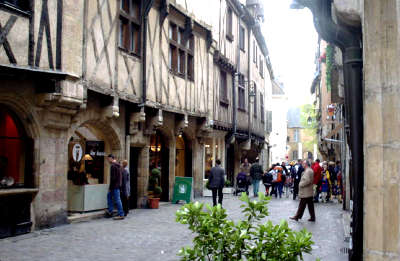
Rue de la Verrerie, in the old centre of Dijon
At the heart of the old city, the Palace of the Dukes of Burgundy, most of it dating from the 18th century, is the most impressive of the old buildings in Dijon. It today houses the city hall, the tourist information office, and the history museum, a free museum with artefacts relating in particular to Burgundian life and history..
Climb to the top of the Tour Philippe le Bon, the tower in the centre of the photo above, for a panoramic view over Dijon.
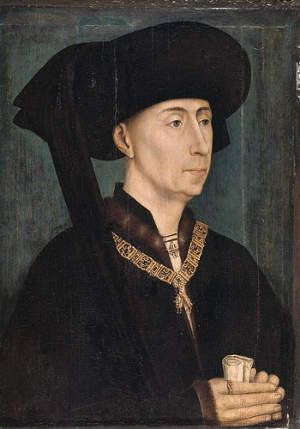
Dijon art gallery -
Portrait of Philippe le Bon, school of Rogier van der Weyden
Running north from just behind the fine art museum is the Rue de la Verrerie, one of the most interesting old streets in the city, with its overhanging half-timbered houses. Running west from the Place de la Liberté is the Rue de la Liberté, one of the main city centre shopping streets; just off this busy pedestrian street, discover the Place Francis Rudé, from which you can follow the rue Rudé, then right into the attractive rue Musette, with its boutiques and cafés. This will take you most interesting old church in Dijon, the 13th century church of Notre Dame, with its very unusual western facade decorated with three superimposed rows of arches. The facade is also decorated with 51 dummy gargoyles (real gargoyles carry away rainwater, "dummy" gargoyles are just decorative). Today's gargoyles are not medieval; the medieval facade was indeed decorated with gargoyles, but these were later removed arter a fatal accident, and those that decorate the facade today were put up in during restoration of the church in the 19th century.
Two other historic churches in the protected central area are worth visiting: Saint Benignus Cathedral is a 13th - 14th century building in a rather severe Burgundian gothic style; by contrast the 16th - 17th century church of Saint Michael, standing 200 metres east of the Ducal Palace. is unique in France, having been started in the gothic style, and completed, notably the west facade and the towers, in the new Renaissance style.
Dijon has two other points of interest for those with an interest in art. The Musée Magnin contains the remarkable collection of a 19th century collector, Maurice Magnin, who acquired over 2000 works of European art from the 16th to the 19th century; including works by Breughel the younger, Cariani, Le Sueur, Bastien-Lepage and Géricault. The museum, with its paintings and decorative arts, is housed in a 17th century residence, the Hôtel Lantin, just opposite the Ducal Palace
The other notable work of art is an early Renaissance sculpture, the Puits de Moise, in the gardens of the Chartreuse hospital. It is located just south of the railway tracks just after the western end of the railway station. Sculpted around 1400 by the Dutch sculptor Claus Sluter, it is a memorial for Duke Philip the Bold, and is considered the finest example of late gothic sculpture.
Places to visit near Dijon

The remarkable medieval
hospice in Beaune - centre for the Burgundy wine trade
There are some other smaller wine producing areas in the north of Burgundy, notably the area round the small town of Chablis. for more on Burgundy wine, see French vineyard areas.
Among the most popular sights and attractions in the area around Dijon are..
- The Burgundy vineyards, and the vineyard trails - la route des vins - taking in some of the most prestigious vineyards at the northern end of the area, including Clos Vougeot, Nuits Saint Georges and Pommard.
- Beaune. The unmissable place to visit on any visit to Burgundy. Renowned as the capital of the Burgundy wine industry, the small city is home to major wine merchants. The old centre is particularly renowned for the Hôtel Dieu, a unique medieval hospice which was still used as a hospital until the late 20th century. The building, with its superb "burgundian" roof of multicoloured glazed tiles, is one of the largest medieval civil buildings surviving to this day. It is home to a priceless work of art, the early Renaissance Beaune Altarpiece by the Flemish artist Rogier van der Weyden... painted for the hospice around 1445, and still there. Accessible by train.
- Auxonne. Standing on the border between Burgundy and Franche-Comté, just over 40 km southeast of Dijon, Auxonne is an attractive small town beside the River Saône. The old town is protected by fortifications which are partly medieval but mostly redesigned by Vauban in the 17th-18th century. The Royal Port, beneath the Vauban ramparts, is a popular riversite marina. Accessible by train.
- The Burgundy Canal Linking the rivers Yonne and Saone, the Burgundy Canal was built between 1775 and 1832. North of Dijon, it meanders pecefully through the hills to the northwest of Dijon, and across the plain to the southeast, and is popular for pleasure boating and as a cycling route.
- The Chateau de Rochepot - the classic Burgundian castle, a medieval castle lovingly restored and embellished in the nineteenth century. With its Burgundian tiled roof and its array of pointed towers, it looks like a fairytale castle. Open March-November daily except Tuesdays.
Accommodation
Click here for a ► choice of hotels in Dijon at best online rates, and the About-France.com hotel selection for Dijon.There is plenty of hotel accommodation in Dijon. For visitors arriving by train, there is a choice of hotels near the railway station or between the station and the old city centre. Visitors arriving by car have the option of either staying in or close to the centre, which may involve additional parking expenses, or else taking a hotel on the outskirts of town and travelling in to the centre by public transport, notably the tram.
Out of town hotels with tram access to the centre
Visitors arriving on the A31 motorway from the north should exit at junction 4, then leave the motorway feeder road at the first exit, following signs for Saint Apollinaire. This will bring them into Dijon on the old D70, where there is a choice of budget and mid-range hotels, within 500 m of a tram stop. Ibis budget, Campanile. Carry on in on the D70 for a second Campanile hotel a kilometre closer to the town centre, or a bit further for a four star Mercure hotel. All these hotels offer free parking.Visitors arriving from Paris should take the Dijon north circular road and circle the city as far as the exit marked D70 Vesoul (St Apollinaire), then follow signs for Dijon Centre or Saint Apollinaire.
For a large mid-range hotel with free parking close to the centre, check out the Ibis Dijon Gare , located just south of the train station. Easily accessible from the Paris direction: just follow Dijon Centre at the end of the A38 motorway, and enter the city on the old main road (D905).
The alternative is to take a hotel in town. See the About-France.com selection
Dijon is a city with excellent road and rail links, but no airport
- By air Dijon is not near any major airport. Nearest airports: Paris, Lyon Saint Exupéry. The nearby Dole airport is served by Ryanair, with seasonal flights from London Stansted. For more details see Fly to France.
- By train Dijon is a major rail hub. It is 1h30 from Paris Gare de Lyon by high-speed train (TGV) and also has high speed TGV links to Besançon, Mulhouse, Lyon, Strasbourg Marseilles and Zürich and intercity links to Reims, Nancy, Lausanne – some using TGV trains. For timetables and online tickets, see Trainline.com .
- By car At the junction of the A31, A38 and A39 motorways, Dijon is easily accessible from Paris, from Calais via Reims, from Germany via Mulhouse, and from the south of France via Lyon.
About-France.com
Home
page - Site search
- Regions
- Maps of France
Plan of Dijon from an open-source original from openstreetmap.org.
Plan of Dijon from an open-source original from openstreetmap.org.
Photo top of page : the Palace of the Dukes of
Burgundy

Five star luxury, between the station and the historic centre. Classic hotel 700 metres on foot from the Ducal Palace
★★★ Hostellerie du Chapeau Rouge
Four-star boutique hotel in old Dijon, with Michelin starred restaurant. Next door to the cathedral. Public parking close by.
★★★ Hotel des Ducs
In the centre of the old town, 100m from the Ducal Palace. Easy access to all main sights. Secure public parking close by.
★★★ Campanile Dijon Congrès
One of several Campanile hotels in Dijon. Easy acccess via D70: on tram route. 800 metres on foot to historic central area.
★★ B&B Hotel Dijon Centre
Between station and centre, a modern two-star budget hotel 500m from the Palais des Ducs. Secure public parking close by.
About-France.com is an independent user-supported website, and may receive commission from sales made on selected partner websites accessible through affiliate links.
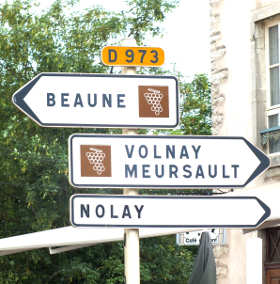
The Burgundy wine trail
Copyright © About-France.com 2007 - 2025
Photo panorama of Place de la Libération by François de Dijon - Hospices de Beaune by Soyignatius. Both Creative commons licence.
Key
tourist information for Dijon:
Region: Burgundy
Nearby cities: Besançon, Macon
Nearest airports: Paris Orly
Dijon is on the routes between:
Luxembourg and Lyon
Paris and Lyon ( A31 / A 32 from A6 and A5)
Population: 151,000
Main sites: the palace of the Dukes of Burgundy, historic city centre, Musée des Beaux Arts
Nearby attractions: The Burgundy vineyards, Beaune, Autun
Region: Burgundy
Nearby cities: Besançon, Macon
Nearest airports: Paris Orly
Dijon is on the routes between:
Luxembourg and Lyon
Paris and Lyon ( A31 / A 32 from A6 and A5)
Population: 151,000
Main sites: the palace of the Dukes of Burgundy, historic city centre, Musée des Beaux Arts
Nearby attractions: The Burgundy vineyards, Beaune, Autun

Dijon hotels
The About-France.com selection
Hotels for all budgets and all needs
★★★★ Grand
hôtel La ClocheHotels for all budgets and all needs
Five star luxury, between the station and the historic centre. Classic hotel 700 metres on foot from the Ducal Palace
★★★ Hostellerie du Chapeau Rouge
Four-star boutique hotel in old Dijon, with Michelin starred restaurant. Next door to the cathedral. Public parking close by.
★★★ Hotel des Ducs
In the centre of the old town, 100m from the Ducal Palace. Easy access to all main sights. Secure public parking close by.
★★★ Campanile Dijon Congrès
One of several Campanile hotels in Dijon. Easy acccess via D70: on tram route. 800 metres on foot to historic central area.
★★ B&B Hotel Dijon Centre
Between station and centre, a modern two-star budget hotel 500m from the Palais des Ducs. Secure public parking close by.
About-France.com is an independent user-supported website, and may receive commission from sales made on selected partner websites accessible through affiliate links.
Click here for
low-cost car hire in France
low-cost car hire in France

The Burgundy wine trail
Copyright © About-France.com 2007 - 2025
Photo panorama of Place de la Libération by François de Dijon - Hospices de Beaune by Soyignatius. Both Creative commons licence.

